Union of cosmic forces
1986/12/01 Martinez Lizarduikoa, Alfontso Iturria: Elhuyar aldizkaria
Symmetrization of the vulnerable area
With Gauge's symmetries at the head in the 1970s and 1980s, physicists Weiberg and Salam began to study electromagnetic force and weak nuclear force to unite both. The problem is to find another symmetry as complex as that of gauge symmetry. These areas could be expressed in this way through a single field, demonstrating that both are the result of a more fundamental force.
Therefore, the first step was to describe weak force by gauge symmetry. To do this, it must be taken into account that the fractions of weak force are leptois (electron and neutrino). Taking this into account, Weiberg and Salam created the concept of "isotopic spin symmetry" in the realm of weak interaction. Through this symmetry the identities of electrons and neutrinos are mixed. To understand it better imagine a fictional command.
Turning this command can confuse the identity of the nuclear fractions.
- When the indicator is at the top, the fraction (or fractions) is 100% electron. As the indicator rotates, the character of the fraction becomes hybrid. Part of the fraction is the electron and the rest is neutrino.
- When the indicator is down, the electron has become neutrino.
The same process can be done with two indicators.
The black indicator turns electrons into neutrinos. All white, neutrino electrons.
- In this case the actual populations of electrons and neutrinos are described. Electrons capture a dose of neutrino and vice versa.
- All electrons have become neutrinos and neutrinos become electrons. All particles have changed their identity.
If this process is analyzed from the point of view of symmetry, an important principle can be postulated: "Nuclear forces are independent of the position of the indicator." This invariance is called "spin's isotopic symmetry."
This invariant is an abstract symmetry. This symmetry is general. And when we reduce this symmetry new fields of force are created to balance the change of scale. These areas of force are precisely those that describe the weak force. The force fields needed to express the weak force are three, which clearly explains that the symmetry below the weak zone is much more complex than the electromagnetic field. To quantify these three fields we must add to each of them a particle (how much). These theoretical particles have been called W +, W - and Z.
Suspension by symmetry
At this point a new problem arises. Gauge zones are areas of great influence. This means that the fractions to be joined with these zones must be of mere mass. But the masses that the theory adds to the fractions W and Z are large and with that aggregation the gauge symmetry disappears.
How to express this contradiction? This problem has been overcome by the process of "breaking the symmetry". To better understand this process, let us think that we have a surface like the one that appears in the image, with a ball on its hill.
The structure we have in Figure 1 (a) is symmetrical (rotational symmetry), but not stable, as it is found in gravitational force. However, if the ball deviates (albeit little) from its equilibrium position, it begins to drift downhill to balance its position. Once equilibrium is reached, symmetry b) has become stability. And in that stable structure the rotational symmetry that is gravitated remains, but hidden. And the real state of the system cannot explain the symmetries of the forces that control this system.
These are therefore areas of gauge symmetry in the description of weak force, which cannot exist in a stable situation exposing their own symmetry. Therefore, by abrupt rupture of symmetry, the field is dissolved, creating a stable state and eliminating symmetry (rather, hiding it), adding mass to the fractions corresponding to the zones in that process. This explains the great mass of fractions W and Z.
Discovery of weak force
If the symmetry of the weak zone (through the isotopic symmetry of spin) wants to unite this field with the electromagnetic field, for both forces one theory must be created: the theory of electroweak force. To achieve this, we must invent another deeper and more complex nocturnal symmetry with what we have learned so far: This symmetry must encompass symmetries of electromagnetic and weak fields.
From this point of view, we will need four fields to describe the electro-weak force; one electromagnetic and another three joined by the weak force.
The theory of this new unified force has been confirmed in two steps. In 1971, all interaction diagrams within this theory were analyzed using computers. And it was stated with great satisfaction that all the infinity of this theory disappeared. The theory, therefore, like quantum electrodynamics, was renormalized and is because the structure of the new theory is very symmetrical.
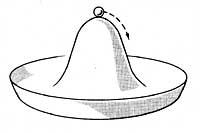
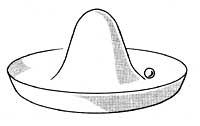
The second conformation took place in 1983. During this year, the W and Z particles were experimentally observed in the Geneva fractions accelerator (2). From this historical moment of science, the four basic forces present in Nature became three.
Birth of Quantum Chromodynamics
Uniting electromangenism and weak nuclear force, scientists have relied on nocturnal symmetry and immediately began to conduct the first trials to unite the electromanticist force with violent force.
The first step to do this is to add a gauge symmetry structure to the strong force. That is, symmetrize the field of violent nuclear force.
To carry out this work we have to take into account the hadrones. Hadrones are fractions that interact in the violent field. These hadrons are made up of simple units called quark.
How to define these quark?. Each quark has a built-in entity equivalent to the electric charge. This equivalent load is the origin of the field. This charge is called “color.” The electromagnetic field is generated through a charge, but to express the interaction between the quarks (called gluon) we need three different types of charges (three colors). According to this each quark can appear in three colors, red, green and blue.
What will be the gauge symmetry added to each zone?. This is: Invariance of the whole system despite the color change of each point of space.
Put another way. Suppose a command with three indicators (red, green and blue).
Its general meaning is the gauge symmetry added to the colors of the quarks.
Therefore, the strength between quarks (gluon) has not always changed, although they turn indicators that mix colors.
When three colors appear, the symmetry of the violent zone will be more complex, so we will need more force zones to keep the symmetry reduced. Specifically, 8 new zones of force will be needed to which 8 particles (8 gluons) are added. Remember that the number of particles added to the electromagnetic field was one (photon) and three (fractions W +, W and Z) to the weak force.
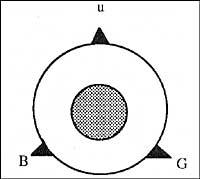
A proton (a hadron) consists of three quark. Among these quark are continuously exchanging gluons and therefore changing their colors. But the law of gauge symmetry says that although they are always exchanges, the sum of the colors we have at the end (green + blue + red) must be.
On this symmetry of Gauge an important branch of physics has been built: Quantum chromodynamics (QKD) (3).
From the point of view of Quantum chromodynamics, the action of Nature to maintain an abstract symmetry is brutal. That is, although the colors of the quarks change, the color of the hadron remains white (green + blue + red).
With QKD fixation, both weak and violent electromagnetic forces have a description depending on the gauge zone. Moreover, two of these three fields (electromagnetic and weak) are united. Is it possible to find a sufficiently complex symmetry to convert these three fields into one?
In search of great unity: BHT theories (4)
The problem of finding a BHT theory is mathematical. And the resolution of this problem is not unique, but multiple. Hence the different competing BHT theories appear. However, in all these theories there are symmetries that mix the force of many particles. To join the electro-weak and violent force we need 22 force fields, of which 12 are known, with their added particles (photon, W +, W -, Z, 8 gluons). We call "Fraction X" the particles of the 10 new forces to be found.
A very important conclusion is given in the BHT theories. According to these theories, the proton must disintegrate over time. In all physical theories the proton has been considered a stable and lasting fraction. BHT theories predict the death of the proton and thus postulates the disappearance of all matter present in the cosmos, since the structure of matter would be built on an unstable fraction. If this type of prediction were experimentally demonstrable, it would be of great importance to check BHT theories. However, the technological problems generated by this type of verification are enormous. Let's analyze the situation.
Proton Death
Based on the principle of Heisenberg's insignificance, it is possible to relate energy (or equivalent mass) to distance. From this point of view, to study small distances we need very large energies. The distance of the X fractions is 10 to 29 cm, the interaction distance of these particles. How much energy is needed to probe such small distances?
The universe of BHT is one million times smaller than that of QUARKS. For the Quark poll we had to use a 3-km fraction accelerator (Standford linear accelerator). According to this, to probe the BHT world we would need an accelerator the size of our solar system. This limitation will not matter to the philosopher, but to the scientist immersed in experimental physics.
Therefore, the study of proton disintegration is not possible today in the laboratory and is never necessary. However, Nature can be considered a great laboratory, in which the phenomena that occur in this cosmic laboratory are analyzed. Thus, if the simplest theory of BHT gives the proton a live average of 10 31 years, this means that if we have 10 31 protons a proton will disintegrate in a year.
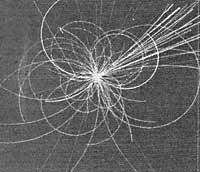
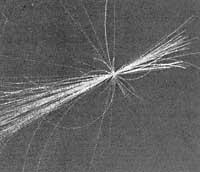
So things, if we put a very large mass of material in a special place (under the shadow of cosmic and neutral rays that can be effective in the experiment), it would be possible to detect the disintegration of certain protons. These experiments are being carried out in deep galleries and caves to curb the influence of cosmic rays and, as we know, so far no great results have been obtained (5).
However, if we did not get concrete results, this would only mean that the simplest BHT is excluded. Because in other theories the life of the proton is much longer.
These experiments that can currently be performed and magnetic monopoles are within the limits of experimental physics. And it seems that on that path there is no clear solution. Therefore, in order to overcome the limits of experimental physics, theoretical physics has emerged with strength and firmness. And from this new path is expected the current development of physics.
OBSERVATIONS
- In English: Quantum Elctrodynamics (QED) Quantification (EDC) In Basque: Quantum Elektrodinamika (QED) I consider that this option for Basque is the most appropriate, since in this way English (international language at scientific level) and Basque come together. Therefore, we will take the word quantum as a name. In any case, it would also be appropriate to use English letters. Technical service A group led by Carlo Rubbia (Centre Européen Recherches Nucléaires) saw in 1983 the bosons W + and W - and the particle Z. For this they had to devise a special essay and build a proton/antiproton fractional talker. Therefore, Carlo Rubbia and Simon Van der Meer received the 1984 Nobel Prize in Physics. In English: Quantum Chrodynamics (QCD) Chromodynamic No. (CDC) In Basque: Quantum Chromodynamics (QKD) Grand Unified Theories (GUT) English: Great Unified Theories (GTU) Euskera: Theories of the Major Union (HSCT) The news of the disintegration of a proton has spread among scientists in recent months. This type of observation should be associated with others in order to confirm with certainty that the proton disintegrates.

Gai honi buruzko eduki gehiago
Elhuyarrek garatutako teknologia








